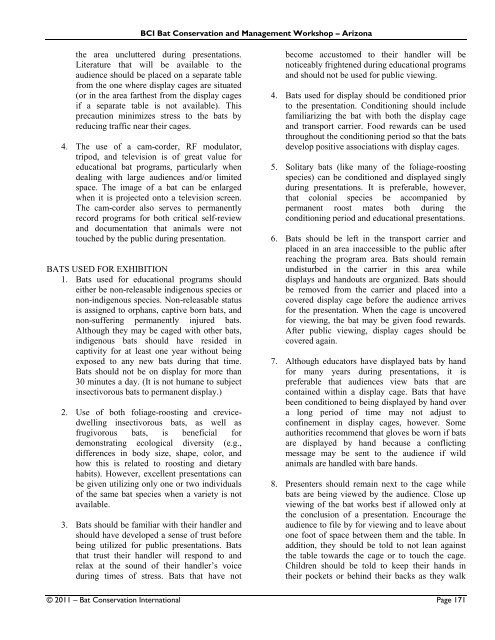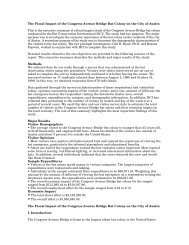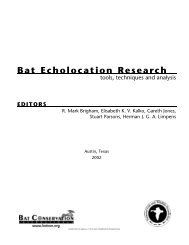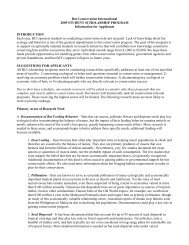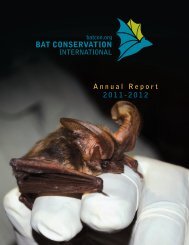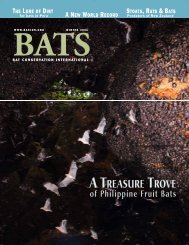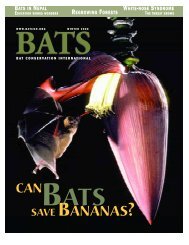Bat Conservation and Management Workshop
Bat Conservation and Management Workshop
Bat Conservation and Management Workshop
You also want an ePaper? Increase the reach of your titles
YUMPU automatically turns print PDFs into web optimized ePapers that Google loves.
BCI <strong>Bat</strong> <strong>Conservation</strong> <strong>and</strong> <strong>Management</strong> <strong>Workshop</strong> – Arizona<br />
the area uncluttered during presentations.<br />
Literature that will be available to the<br />
audience should be placed on a separate table<br />
from the one where display cages are situated<br />
(or in the area farthest from the display cages<br />
if a separate table is not available). This<br />
precaution minimizes stress to the bats by<br />
reducing traffic near their cages.<br />
4. The use of a cam-corder, RF modulator,<br />
tripod, <strong>and</strong> television is of great value for<br />
educational bat programs, particularly when<br />
dealing with large audiences <strong>and</strong>/or limited<br />
space. The image of a bat can be enlarged<br />
when it is projected onto a television screen.<br />
The cam-corder also serves to permanently<br />
record programs for both critical self-review<br />
<strong>and</strong> documentation that animals were not<br />
touched by the public during presentation.<br />
BATS USED FOR EXHIBITION<br />
1. <strong>Bat</strong>s used for educational programs should<br />
either be non-releasable indigenous species or<br />
non-indigenous species. Non-releasable status<br />
is assigned to orphans, captive born bats, <strong>and</strong><br />
non-suffering permanently injured bats.<br />
Although they may be caged with other bats,<br />
indigenous bats should have resided in<br />
captivity for at least one year without being<br />
exposed to any new bats during that time.<br />
<strong>Bat</strong>s should not be on display for more than<br />
30 minutes a day. (It is not humane to subject<br />
insectivorous bats to permanent display.)<br />
2. Use of both foliage-roosting <strong>and</strong> crevicedwelling<br />
insectivorous bats, as well as<br />
frugivorous bats, is beneficial for<br />
demonstrating ecological diversity (e.g.,<br />
differences in body size, shape, color, <strong>and</strong><br />
how this is related to roosting <strong>and</strong> dietary<br />
habits). However, excellent presentations can<br />
be given utilizing only one or two individuals<br />
of the same bat species when a variety is not<br />
available.<br />
3. <strong>Bat</strong>s should be familiar with their h<strong>and</strong>ler <strong>and</strong><br />
should have developed a sense of trust before<br />
being utilized for public presentations. <strong>Bat</strong>s<br />
that trust their h<strong>and</strong>ler will respond to <strong>and</strong><br />
relax at the sound of their h<strong>and</strong>ler‘s voice<br />
during times of stress. <strong>Bat</strong>s that have not<br />
become accustomed to their h<strong>and</strong>ler will be<br />
noticeably frightened during educational programs<br />
<strong>and</strong> should not be used for public viewing.<br />
4. <strong>Bat</strong>s used for display should be conditioned prior<br />
to the presentation. Conditioning should include<br />
familiarizing the bat with both the display cage<br />
<strong>and</strong> transport carrier. Food rewards can be used<br />
throughout the conditioning period so that the bats<br />
develop positive associations with display cages.<br />
5. Solitary bats (like many of the foliage-roosting<br />
species) can be conditioned <strong>and</strong> displayed singly<br />
during presentations. It is preferable, however,<br />
that colonial species be accompanied by<br />
permanent roost mates both during the<br />
conditioning period <strong>and</strong> educational presentations.<br />
6. <strong>Bat</strong>s should be left in the transport carrier <strong>and</strong><br />
placed in an area inaccessible to the public after<br />
reaching the program area. <strong>Bat</strong>s should remain<br />
undisturbed in the carrier in this area while<br />
displays <strong>and</strong> h<strong>and</strong>outs are organized. <strong>Bat</strong>s should<br />
be removed from the carrier <strong>and</strong> placed into a<br />
covered display cage before the audience arrives<br />
for the presentation. When the cage is uncovered<br />
for viewing, the bat may be given food rewards.<br />
After public viewing, display cages should be<br />
covered again.<br />
7. Although educators have displayed bats by h<strong>and</strong><br />
for many years during presentations, it is<br />
preferable that audiences view bats that are<br />
contained within a display cage. <strong>Bat</strong>s that have<br />
been conditioned to being displayed by h<strong>and</strong> over<br />
a long period of time may not adjust to<br />
confinement in display cages, however. Some<br />
authorities recommend that gloves be worn if bats<br />
are displayed by h<strong>and</strong> because a conflicting<br />
message may be sent to the audience if wild<br />
animals are h<strong>and</strong>led with bare h<strong>and</strong>s.<br />
8. Presenters should remain next to the cage while<br />
bats are being viewed by the audience. Close up<br />
viewing of the bat works best if allowed only at<br />
the conclusion of a presentation. Encourage the<br />
audience to file by for viewing <strong>and</strong> to leave about<br />
one foot of space between them <strong>and</strong> the table. In<br />
addition, they should be told to not lean against<br />
the table towards the cage or to touch the cage.<br />
Children should be told to keep their h<strong>and</strong>s in<br />
their pockets or behind their backs as they walk<br />
© 2011 – <strong>Bat</strong> <strong>Conservation</strong> International Page 171


